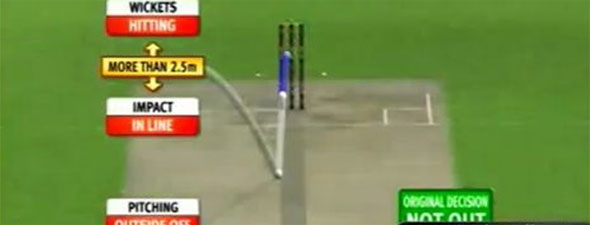
Having not blogged about cricket for at least two weeks, dear reader, it is time to return to the venerable (and vulnerable) game.
Watching the current England vs Pakistan test series (played in the ‘neutral’ venue of Dubai) has been a surreal, synthetic and sterile affair. Played in brand new, magnificent and empty stadiums, you can hear the players’ chat like you might at your local park. I think there are spectators present, but they must be directly underneath the main camera stands, because the cursory pan of the ground betrays a complete lack of spectators, and when they do show some cheering fans, it seems to be the same 20 or so (green screened perhaps?).
But it’s the DRS (“decision review system”) which troubles me. On golden day of yore (like when I was taught the forward defensive back in the 1970s) an umpire’s decision was final, and you took great pride in swinging your bat under your arm and walking with great aplomb towards the pavilion as if to say “you may have got me today, but next time…”. Some players made the ‘walk back to the pavilion’ the best part of their game. These days, we have technology that can show up the slightest flick of the bat, a touch of a glove, a merest caress of the thigh pad, such that the poor umpire looks incredibly foolish when their decision (made in a split second with no replay, often under pressure of 11 screaming fielders and a baying crowd) proves to be inaccurate.
And so it came do to pass a few years ago that the players on either side were allowed two (unsuccessful) technological challenges per innings. If technology agreed with their challenge, they could keep challenging to their heart’s delight. I am in favour of getting the right decision and using the technology, but the upshot of this has been the unedifying sight of players consulting with each other for a few seconds as to whether they might challenge an umpire, or worse ‘gaming the system’ such that the challenge has little to do with the correctness of the decision, but more to do with how many challenges they have left, whether they should store some up for later, etc. I was always taught to accept the umpire’s decision, as being part of the game, but now they are relegated to nothing much more than ball counters with the real arbiters being a combination of hot spot, hawkeye, slow cam, 3rd umpire (up in a box somewhere with access to all the technology) along with the initial thoughts of the umpire on the field. Surely we should let the umpires review the technology together and make the decision? Take the players out of it. If the umpire is sure as eggs are eggs the guy is out or not out, make the decision on the field; but if they have some doubt, let them consult with their colleagues and all the technology available, and make a reasonable decision based on that. Players walk away and await the decision.
I know the system was designed to remove the howlers, and it has, but it has another problem – it has led to turgid cricket by making the stumps “larger”. With LBWs, you never know (never) whether the ball would have gone on to hit the stumps. You may feel confident one way or another, but you never know what would have happened if the ball had been allowed to travel unimpeded towards the stumps. Hawkeye (using ball tracking software) estimates its likely path, that’s all it can do. The system today decrees that if the umpire rules the batsman out LBW, all the ‘predicted ball path’ has to do is hit any part of the stumps to uphold his decision (even the most outside coat of varnish). If he had said “not out”, then to overrule the decision, the ball would have to be hitting inside the stumps. This has meant umpires now give far more LBWs knowing that even with a challenge, they are unlikely to be shown wrong. Before the DRS, umpires waved the appeal away thinking “well it could have been sliding down the leg side”, and the commentators would have agreed. 41 LBWs have been given in the current England Pakistan series, a record for a three test series and only 2 off the record for a five test series. With 10 England wickets to fall the record will be broken (probably today!). The umpires are in danger of repetitive strain disorder such are their finger lifting habits.
The balance of bat against ball has changed, and the DRS has shifted this. The games in Dubai have been boring attritional affairs with less than 2 runs per over and batsmen waiting like doomed rabbits in the headlights prodding and poking away in front of larger ‘virtual’ stumps.
Put the DRS into umpires hands, and let’s get back to playing cricket and accepting the umpires’ verdict!
